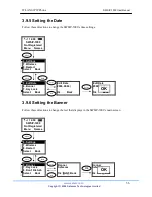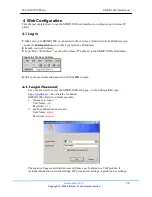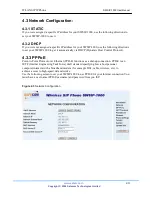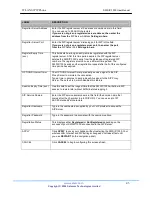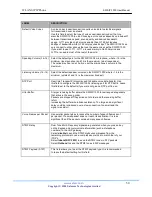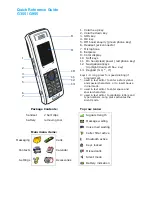
WLAN SIP IP Phone
SWSIP-1000 User Manual
www.safecom.cn
50
Copyright © 2006 Safecom Technologies Limited
LABEL
DESCRIPTION
Default Voice Codec
A voice codec (coder/decoder) converts voice data to electrical signals
for transmission over a network.
Use this field to select the type of voice coder/decoder (codec) that you
want the SWSIP-1000 to use. Choosing a voice codec depends on a tradeoff
between transmission speed, sound quality and desired bandwidth
usage. G.711 provides higher voice quality than G.729 but requires
64kbps of bandwidth while G.729 only requires 8kbps. The SWSIP-1000 can
only connect to other phones that use the same codec as the SWSIP-1000.
If you want to use G.711, G.711u is used mainly in North America and
G.711a is used in most of the rest of the world.
Speaking Volume(-14~14)
Select the default gain for the SWSIP-1000’s microphone, where –14 is the
minimum (least sensitive) and 14 is the maximum (most responsive).
The callee may hear an echo if you set the microphone’s volume to the
maximum.
Listening Volume(-14~14)
Select the default speaker volume on the SWSIP-1000, where –14 is the
minimum (quietest) and 14 is the maximum (loudest).
RTP Port
Real time Transport Protocol is used to handle voice data transfer. Use
this field to configure the SWSIP-1000’s listening port for RTP traffic. Leave
this field set to the defaults if you were not given a RTP port to use.
Jitter Buffer
A larger receiving buffer allows the SWSIP-1000 to rearrange data packets
that arrive in the wrong order.
Packets are dropped if they arrive out of order and the receiving buffer
is full.
Increasing the buffer size introduces latency. Too large and a significant
delay could be introduced over a slow connection, too small and the
signal may distort.
Voice Frames per Packet
Use smaller packet sizes to reduce the number of speech frames sent
per packet. If a small packet does not reach its destination it is less
significant than if the packet contained many speech frames.
DTMF Relay
Dual Tone Multi-Frequency signals are generated when you press a key
on the Keypad and communicate information (such as telephone
numbers) to the VoIP gateway.
Select
disable
to send the DTMF digits uncompressed from the
remaining protocols to use a compression method to match that of your
ITSP’s.
Select
Inband(RFC 2833)
to send the DTMF tones in RTP packets.
Select
Outband
to send the DTMF tones in SIP messages.
DTMF Payload (0-127)
This field allows you to set the DTMF payload type. It is recommended
to leave the default setting for this field.

